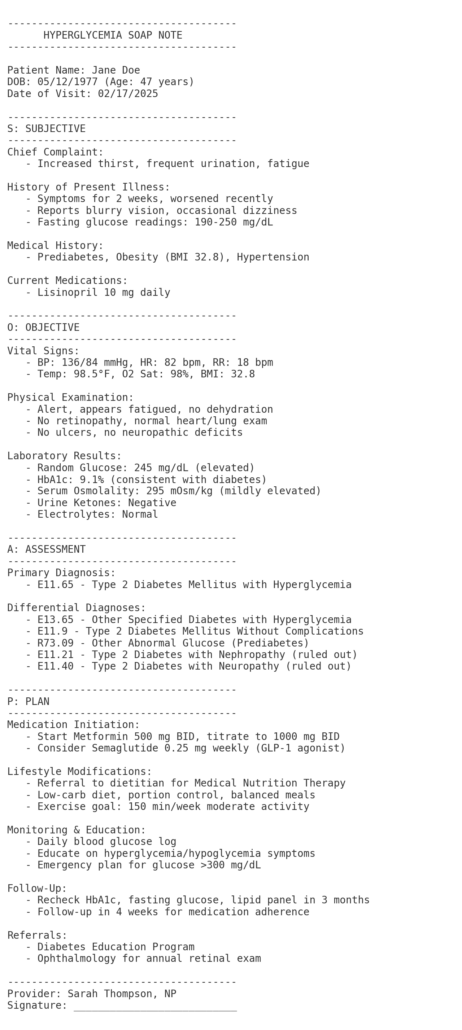Hyperglycemia SOAP Note – Nurse Practitioner SOAP Note

Subjective:
CC (Chief Complaint):
47-year-old African American female presents with complaints of fatigue, excessive thirst, and frequent urination over the past two weeks. She also reports intermittent blurry vision and occasional dizziness.
HPI:
- Onset: Symptoms started gradually approximately two weeks ago.
- Duration: Persistent, occurring daily.
- Character:
- Increased thirst (polydipsia) and urination (polyuria).
- Fatigue and occasional dizziness.
- Reports feeling weak and sluggish.
- Occasional nausea but no vomiting.
- Intermittent blurry vision, particularly in the mornings.
- Admits to increased carbohydrate intake due to work stress.
- Aggravating Factors: High-carb meals, lack of physical activity.
- Relieving Factors: Drinking water, resting.
- Blood Sugar Control:
- Patient has a history of prediabetes but was not on medication.
- Recent home glucose readings: 190-250 mg/dL (fasting).
- No history of prior diabetic ketoacidosis (DKA).
Past Medical History:
- Prediabetes (diagnosed 2 years ago, previously managed with diet & exercise).
- Obesity (BMI 32.8 kg/m²).
- Hypertension (diagnosed 5 years ago, on medication).
Current Medications:
- Lisinopril 10 mg daily (for hypertension).
- Multivitamin daily.
Allergies:
- No known drug allergies.
ROS:
- GENERAL: Reports increased thirst, fatigue, and dizziness.
- HEENT: Intermittent blurry vision, no headaches.
- CARDIOVASCULAR: No chest pain, no palpitations.
- RESPIRATORY: No shortness of breath or cough.
- GASTROINTESTINAL: Reports mild nausea and no vomiting.
- GENITOURINARY: Increased urination, no dysuria or hematuria.
- MUSCULOSKELETAL: No joint pain or swelling.
- NEUROLOGICAL: Reports mild dizziness and no focal neurological deficits.
- ENDOCRINOLOGIC: Reports increased hunger and dry mouth.
Objective:
Vital Signs:
- BP: 136/84 mmHg
- HR: 82 bpm
- RR: 18 bpm
- Temp: 98.5°F
- O2 Sat: 98% on room air
- Weight: 212 lbs (BMI 32.8 kg/m² – Obese)
Physical Examination:
- General: Alert, cooperative, appears fatigued.
- HEENT: No signs of dehydration, no icterus, no retinopathy.
- Cardiovascular: Normal heart sounds, no murmurs.
- Respiratory: Clear to auscultation bilaterally.
- Abdomen: Soft, non-tender, no hepatosplenomegaly.
- Neurological: Normal reflexes, intact sensation in extremities.
- Skin: No ulcers, no signs of infection.
Laboratory Results (Today’s Visit):
- Random Glucose: 245 mg/dL (elevated)
- HbA1c: 9.1% (consistent with new-onset diabetes)
- Serum Osmolality: 295 mOsm/kg (mildly elevated)
- Urine Ketones: Negative
- Serum Electrolytes:
- Sodium: 136 mmol/L
- Potassium: 4.1 mmol/L
- Bicarbonate: 24 mmol/L
- Creatinine: 1.0 mg/dL (normal kidney function)
Assessment:
Primary Diagnosis:
🩺 E11.65 – Type 2 Diabetes Mellitus with Hyperglycemia
- Rationale:
- Patient presents with classic symptoms of hyperglycemia (polydipsia, polyuria, fatigue, blurry vision).
- Fasting blood glucose >126 mg/dL and HbA1c >6.5% confirm the diagnosis of new-onset Type 2 Diabetes Mellitus.
- No signs of diabetic ketoacidosis (DKA) or hyperosmolar hyperglycemic state (HHS), making the primary diagnosis uncontrolled Type 2 Diabetes with hyperglycemia rather than an acute metabolic crisis.
Differential Diagnoses & Rationale:
- E13.65 – Other Specified Diabetes Mellitus with Hyperglycemia
- Used if this was a case of secondary diabetes (e.g., from corticosteroid use or pancreatic dysfunction), which is not the case here.
- E11.9 – Type 2 Diabetes Mellitus Without Complications
- This code is not selected because the patient presents with symptomatic hyperglycemia, which is a complication requiring intervention.
- R73.09 – Other Abnormal Glucose
- Used for prediabetes or stress-induced hyperglycemia. Not applicable, as the patient now meets full diabetes criteria.
- E11.21 – Type 2 Diabetes Mellitus with Diabetic Nephropathy
- Not selected since urine microalbumin is normal, and there is no evidence of kidney dysfunction.
- E11.40 – Type 2 Diabetes Mellitus with Diabetic Neuropathy
- Ruled out as there are no significant neuropathic symptoms at this time.
Plan (Treatment & Rationale):
1. Medication Initiation:
- Start Metformin 500 mg PO BID (gradual titration to 1000 mg BID).
- Rationale: First-line therapy for Type 2 Diabetes. It improves insulin sensitivity, and lowers glucose production.
- Consider adding GLP-1 receptor agonist (Semaglutide 0.25 mg weekly).
- Rationale: Beneficial for weight loss and glucose control.
2. Lifestyle Modifications:
📌 Dietary Changes:
- Referral to a Registered Dietitian for Diabetes Medical Nutrition Therapy (MNT).
- Focus on low-carb diet, portion control, and balanced meals.
🏃 Exercise Plan:
- Goal: 150 minutes/week of moderate aerobic exercise (walking, swimming).
- Rationale: Increases insulin sensitivity and lowers blood glucose.
3. Hyperglycemia Monitoring & Patient Education:
- Blood glucose log (fasting & postprandial readings).
- Educate on signs of hyperglycemia & hypoglycemia.
- Emergency plan if glucose >300 mg/dL or signs of HHS/DKA occur.
4. Lab Monitoring & Follow-Up:
📌 Repeat labs in 3 months:
- HbA1c, fasting glucose, lipid panel, urine microalbumin.
📌 Follow-up in 4 weeks:
- Assess medication adherence, glucose trends, side effects.
- Consider medication adjustment if fasting glucose >200 mg/dL after 1 month.
5. Referral Considerations:
- Diabetes Education Program for self-management skills.
- Ophthalmology referral for annual retinal exam.
Preceptor Verification:
I confirm the patient used for this assignment is a patient that was seen and managed by the student at their Meditrek-approved clinical site during this quarter course of learning
